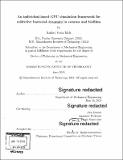An individual-based GPU simulation framework for collective bacterial dynamics in swarms and biofilms
Author(s)
Mok, Rachel V.(Rachel Verla)
Download1117713879-MIT.pdf (15.57Mb)
Other Contributors
Massachusetts Institute of Technology. Department of Mechanical Engineering.
Advisor
Jörn Dunkel.
Terms of use
Metadata
Show full item recordAbstract
With recent technological advancements, observations and measurements of complex bacterial communities at single-cell resolution are now possible. Guided by these rich experimental data sets, we develop minimal individual-based models to uncover the governing forces driving the dynamics in microbial systems. Our model incorporates the biophysical processes of cell growth and division, viscous drag, bacteria self-propulsion, and mechanical cell-surface and cell-cell interactions through interaction potentials. In particular, our cell-cell interaction potential accounts for hard steric and osmotic repulsion as well as attraction mediated through secreted components which bind cells together. Implementing this model on graphics processing units (GPUs) such that the computational time scales linearly with the system size, we achieve a 10x speedup over a comparable code written on central processing units (CPUs). With this simulation framework, we investigate the collective dynamics of Bacillus subtilis swarm expansion and Vibrio cholerae biofilm formation. Our experimental and numerical results imply that mechanical cell-cell interactions dominate the swarming motility phases and can account for the emergence of order and structure seen in growing biofilms. Furthermore, this model is used to explore the effectiveness of surface topography on deterring biofilm formation by investigating how locally varying boundary curvature impact the scattering and accumulation dynamics of swimming bacteria. This work shows great promise at increasing our understanding of the physics governing microbial communities, which knowledge is essential to control and inhibit bacterial populations.
Description
Thesis: Ph. D., Massachusetts Institute of Technology, Department of Mechanical Engineering, 2019 Cataloged from PDF version of thesis. Includes bibliographical references (pages 121-133).
Date issued
2019Department
Massachusetts Institute of Technology. Department of Mechanical EngineeringPublisher
Massachusetts Institute of Technology
Keywords
Mechanical Engineering.